Factors Influencing Online Hotel Booking: Extending UTAUT2 with Age, Gender, and Experience as Moderators
Abstract
1. Introduction
2. Research Model and Research Hypotheses
2.1. Background of UTAUT2 Model
- PE: the degree to which using a technology will provide benefits to consumers.
- EE: the degree of ease associate with consumers’ use of technology.
- SI: the extent to which consumers perceive that important others (family and friends) believe they should use a particular technology.
- FC: consumers’ perceptions of the resources and support available to perform a behavior.
- According to UTAUT, PE, EE, SI, and FC are theorized to influence the behavioral intention to use a technology, while behavioral intention and FC determines technology use.
- HM: the fun or pleasure derived from using a technology.
- PV: consumers’ cognitive tradeoff between the perceived benefits of the applications and the monetary cost for using them.
- Experience: an opportunity to use a target technology.
- Habit: the extent to which people tend to perform behaviors automatically because of learning.
- In UTAUT2, PE, EE, SI, FC HM, PV and habit influence behavioral intention, while behavioral intention, FC, PV and habit influence use behavior. Age, gender, and experience play as moderators. (See Figure 1 for more detailed relations).
- Since this study focuses on consumers’ technology acceptance and use context, the UTAUT2 model is adapted as the fundamental prototype of our research framework. The constructs used in the model are explored and our hypotheses based on the model are tested to identify the key factors affecting consumers’ online hotel booking use intention and behavior.
- On the basis of the UTAUT2 model, this paper proposed the hypotheses in the following sections.
2.2. Performance Expectancy (PE) and Behavioral Intention (BI)
2.3. Effort Expectancy (EE) and Behavioral Intention (BI)
2.4. Social Influence (SI) and Behavioral Intention (BI)
2.5. Facilitating Conditions (FC), Behavioral Intention (BI), and Use Behavior (UB)
2.6. Hedonic Motivation (HM) and Behavioral Intention (BI)
2.7. Price Value (PV) and Behavioral Intention (BI)
2.8. Habit Behavior (HT), Behavioral Intention (BI), and Use Behavior (UB)
2.9. Behavioral Intention (BI) and Use Behavior (UB)
2.10. Moderating Effects of Gender, Age, Experience within UTAUT2
3. Methodology
3.1. Data Collection
3.2. Survey Instrument
3.3. Data Analysis
4. Results
4.1. Descriptive Statistics of Measurement Items
4.2. Structural Equation Modelling (SEM)
4.2.1. Measurement Model
4.2.2. Structural Model
4.2.3. Coefficient of Determination (R2)
4.2.4. Spurious Correlation Test
5. Discussion
5.1. Theoretical Contributions
5.2. Managerial Implications
5.3. Limitations and Future Research
6. Conclusions
Author Contributions
Funding
Conflicts of Interest
References
- Market Intelligence Consulting, Taiwan. Online Purchase reached 45% of Total Purchases. 2018. Available online: https://mic.iii.org.tw/IndustryObservations_PressRelease02.aspx?sqno=488 (accessed on 2 April 2019).
- Akrivos, C.; Ladkin, A.; Reklitis, P. Hotel managers’ career strategies for success. Int. J. Contemp. Hosp. Manag. 2007, 19, 107–119. [Google Scholar] [CrossRef]
- Kayaman, R.; Arasli, H. Customers based brands equity: Evidence from hotel Industry. Manag. Serv. Qual. 1007, 17, 92–109. [Google Scholar] [CrossRef]
- Kuo, C.M. The managerial implications of an analysis of tourist profiles & international hotel employee service attitude. Int. J. Hosp. Manag. 2009, 28, 302–309. [Google Scholar]
- Tsai, C.W. The important effect of employee’s emotion management ability on his/her service behavior in the international tourist hotel. Serv. Ind. J. 2009, 29, 1437–1449. [Google Scholar] [CrossRef]
- Liao, S.H.; Hu, D.C.; Chung, H.Y. The relationship between leader-member relations, job satisfaction and organizational commitment in international tourist hotels in Taiwan. Int. J. Hum. Resour. Manag. 2009, 20, 1810–1826. [Google Scholar] [CrossRef]
- Davis, F.D. Perceived usefulness, perceived ease of use and user acceptance of information technology. MIS Q. 1989, 13, 319–340. [Google Scholar] [CrossRef]
- Rose, G.; Straub, D.W. Predicting general IT use: Applying TAM to the Arabic World. J. Glob. Inf. Manag. 1998, 6, 39–46. [Google Scholar] [CrossRef][Green Version]
- Straub, D.W.; Keil, M.; Brennan, W. Testing the technology acceptance model across cultures: A three country study. Inf. Manag. 1997, 33, 1–11. [Google Scholar] [CrossRef]
- Venkatesh, V.; Morris, M.G.; Davis, G.B.; Davis, F.D. User acceptance of information technology: Toward a unified view. MIS Q. 2003, 27, 425–478. [Google Scholar] [CrossRef]
- Legris, P.; Ingham, J.; Collerette, P. Why do people use information technology? A critical review of the technology acceptance model. Inf. Manag. 2003, 40, 191–204. [Google Scholar] [CrossRef]
- Venkatesh, V.; Thong, J.; Xu, X. Consumer acceptance and use of information technology: Extending the unified theory of acceptance and use of technology. MIS Q. 2012, 36, 157–178. [Google Scholar] [CrossRef]
- Moran, K. Main micronutrient forms/products available and methods of application. In Proceedings of the IFA Agriculture Conference Workshop on micronutrients, Kunming, China, 27 February–2 March2006. [Google Scholar]
- Cheng, T.C.E.; Lam, D.Y.C.; Yeung, A.C.L. Adoption of internet banking: An empirical study in Hong Kong. Decis. Support Syst. 2006, 42, 1558–1572. [Google Scholar] [CrossRef]
- Lai, Y.H.; Huang, H.C.; Lu, R.S.; Chang, C.M. The effects of website trust, perceived ease of use, and perceived usefulness on consumers’ online booking intention: Evidence from Taiwan B&B sector. Life Sci. J. 2013, 10, 1516–1523. [Google Scholar]
- Sun, S.Y.; Lou, Y.S.; Chao, P.J.; Wu, C.Y. A study on the factors influencing the users’ intention in human recruiting sites. J. Hum. Resour. Manag. 2008, 8, 1–23. [Google Scholar]
- Tsao, C.C.; Shieh, J.T.; Jan, Y.L. The study on usage intentions of property service providers for property management system: Application of UTAUT model. J. Bus. Adm. 2009, 80, 33–66. [Google Scholar]
- Lai, Y.H.; Huang, H.C.; Chang, C.M.; Chun, S.Y. Affecting Taiwanese college students’ digital music download behavioral intention: An empirical study. Res. J. Appl. Sci. Eng. Technol. 2013, 5, 2118–2121. [Google Scholar] [CrossRef]
- Moore, G.C.; Benbasat, I. Development of an instrument to measure the perceptions of adoption: An information technology innovation. Inf. Syst. Res. 1991, 2, 192–222. [Google Scholar] [CrossRef]
- Huang, H.C.; Lai, Y.H.; Chang, C.M.; Lu, R.S.; Lai, W.C. Exploring the Facebook influence team identification on Chinese Professional Baseball League (CPBL): A perspective of social influence model. Energy Educ. Sci. Technol. Part B Soc. Educ. Stud. 2012, 4, 1363–1368. [Google Scholar]
- Ajzen, I. The theory of planned behavior. Organ. Behav. Hum. Decis. Process. 1991, 50, 179–211. [Google Scholar] [CrossRef]
- Al-Khaldi, M.A.; Wallace, R.S.O. The influence of attitudes on personal computer utilization among knowledge workers: The case of Saudi Arabia. Inf. Manag. 1999, 36, 185–204. [Google Scholar] [CrossRef]
- Shu, W.; Chuang, Y.H. Investigation of Behavior of Wiki Users. J. E-Bus. 2009, 11, 185–212. [Google Scholar]
- Holbrook, M.B.; Hirschman, E.C. The experiential aspects of consumption: Consumer fantasies, feelings, and fun. J. Consum. Res. 1982, 9, 132–140. [Google Scholar] [CrossRef]
- Brown, S.A.; Venkatesh, V. Model of adoption of technology in the household: A baseline model test and extension incorporating household life cycle. MIS Q. 2005, 29, 399–426. [Google Scholar] [CrossRef]
- Thong, Y.L.; Hong, S.J.; Tam, Y.K. The effects of post-adoption beliefs on the expectation-confirmation model for information technology continuance. Int. J. Hum. Comput. Stud. 2006, 64, 799–810. [Google Scholar] [CrossRef]
- Deaux, K.; Lewis, L.L. Structure of gender stereotypes: Interrelationships among components and gender label. J. Personal. Soc. Psycbol. 1984, 46, 991–1004. [Google Scholar] [CrossRef]
- Chan, K.Y.; Gong, M.; Xu, Y.; Thong, J.Y.L. Examining user acceptance of SMS: An empirical study in China and Hong Kong. In Proceedings of the 12th Pacific Asia Conference on Information System, Suzhou, China, 3–7 July 2008. [Google Scholar]
- Escobar-Rodríguez, T.; Carvajal-Trujillo, E. Online drivers of consumer purchase of website airline tickets. J. Air Transp. Manag. 2013, 32, 58–64. [Google Scholar] [CrossRef]
- Chong, A.Y.L.; Ngai, T.W. What influences travelers’ adoption of a location-based social media service for their travel planning? In Proceedings of the 2013 Pacific Asia Conference on Information Systems, Jeju Island, Korea, 18–22 June 2013.
- Taylor, S.; Todd, P. Assessing IT usage: The role of prior experience. MIS Q. 1995, 19, 561–570. [Google Scholar] [CrossRef]
- Ajzen, I. Perceived behavioral control, self-efficacy, locus of control, and the theory of planned behavior. J. Appl. Soc. Psychol. 2002, 32, 665–683. [Google Scholar] [CrossRef]
- Kim, S.S.; Malhotra, N.K.; Narasimhan, S. Two competing perspectives on automatic use: A theoretical and empirical comparison. Inf. Syst. Res. 2005, 16, 418–432. [Google Scholar] [CrossRef]
- Raman, A.; Don, Y. Preservice teachers’ acceptance of learning management software: An application of the UTAUT2 model. Int. Educ. Stud. 2013, 6, 157–164. [Google Scholar] [CrossRef]
- Gefen, D.; Straub, D.W. Gender differences in the perception and use of E-mail: An extension to the technology acceptance model. MIS Q. 1997, 21, 389–400. [Google Scholar] [CrossRef]
- Mikkelsen, P.M. Shelled opisthobranches. Adv. Mar. Biol. 2002, 42, 67–136. [Google Scholar]
- Davis, F.D.; Bagozzi, R.P.; Warshaw, P.R. Extrinsic and intrinsic motivation to use computers in the workplace. J. Appl. Soc. Psychol. 1992, 22, 1111–1132. [Google Scholar] [CrossRef]
- Thompson, R.L.; Haggins, C.A.; Howell, J.M. Personal computing: Toward a conceptual model of utilization. MIS Q. 1991, 15, 124–143. [Google Scholar] [CrossRef]
- Morris, M.G.; Venkatesh, V. Age differences in technology adoption decisions: Implications for a changing workforce. Pers. Psychol. 2000, 53, 375–403. [Google Scholar] [CrossRef]
- Binde, J.; Fuksa, M. Mobile technologies and services development impact on mobile internet usage in Latvia. Manag. Organ. Syst. Res. 2013, 67, 23–37. [Google Scholar] [CrossRef]
- Kock, N. Warp PLS 4.0 User Manual; Script Warp Systems: Laredo, TX, USA, 2013. [Google Scholar]
- Bock, G.W.; Zmud, R.; Kim, Y.G.; Lee, J.N. Behavioral intention formation in knowledge sharing: Examining the roles of extrinsic motivators, social-psychological forces, and organizational climate. MIS Q. 2005, 29, 87–112. [Google Scholar] [CrossRef]
- Hulland, J. Use of partial least squares (PLS) in strategic management research: A review of four recent studies. Strateg. Manag. J. 1999, 20, 195–204. [Google Scholar] [CrossRef]
- Fornell, C.; Larcker, D.F. Evaluating structural equation models with unobservable variables and measurement error. J. Mark. Res. 1981, 18, 39–50. [Google Scholar] [CrossRef]
- Hwang, F.M. Structural Equation Modeling: Theory and Applications; Wu-Nan Book Inc.: Taipei, Taiwan, 2004. [Google Scholar]
- Hair, J.F.; Hult, G.T.M.; Ringle, C.M.; Sarstedt, M. A Primer on Partial Least Squares Structural Equation Modeling (PLS-SEM); Sage: Thousand Oaks, CA, USA, 2014. [Google Scholar]
- Chang, C.M. The relationship among participation in leisure sports, flow experience, life satisfaction and the degree of depression for the elderly in Chiayi City. Phys. Educ. J. 2009, 42, 113–129. [Google Scholar]
- Compeau, D.R.; Higgins, C.A. Computer self-efficacy: Development of a measure and initial test. MIS Q. 1995, 19, 189–211. [Google Scholar] [CrossRef]
- Wang, C.C.; Chen, H.; Chiang, I.P.; Jiang, W.B. Facebook motivation scale: Development and validation. J. E-Bus. 2013, 15, 319–352. [Google Scholar]
- Wu, J.P.; Lin, C.J. A study of the user adopt of BI system. Electron. Commer. Stud. 2008, 6, 353–376. [Google Scholar]
- Liu, W.L. A path comparison of Web-ATM adoption between genders. J. Sci. Technol. Humanit. Transw. Inst. Technol. 2009, 9, 1–15. [Google Scholar]
- Liu, L.; Chang, C.; Huang, H.; Chang, Y. Verification of Social Network Site Use Behavior of the University Physical Education Students. Eurasia J. Math. Sci. Technol. Educ. 2016, 12, 793–805. [Google Scholar] [CrossRef]
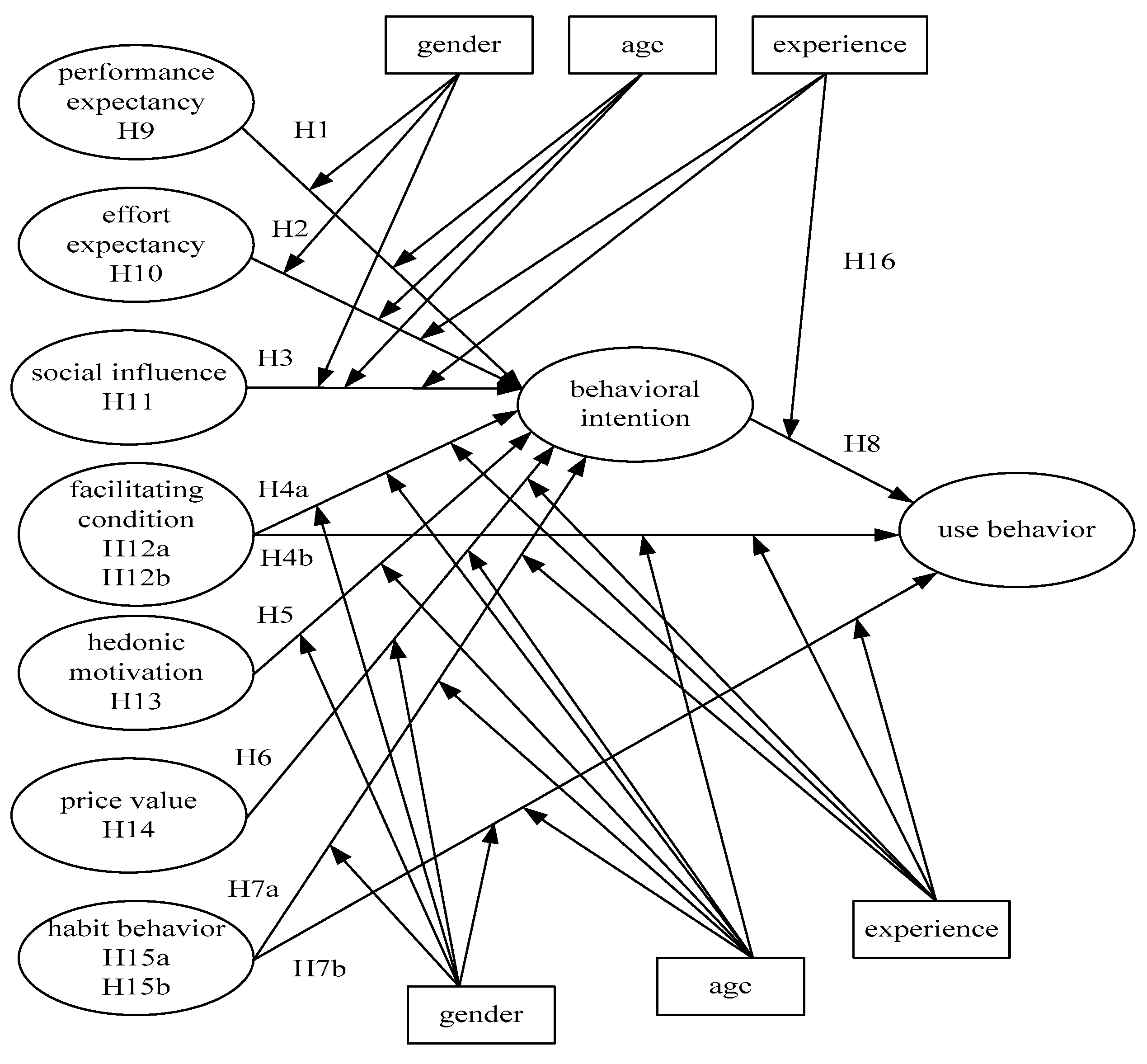
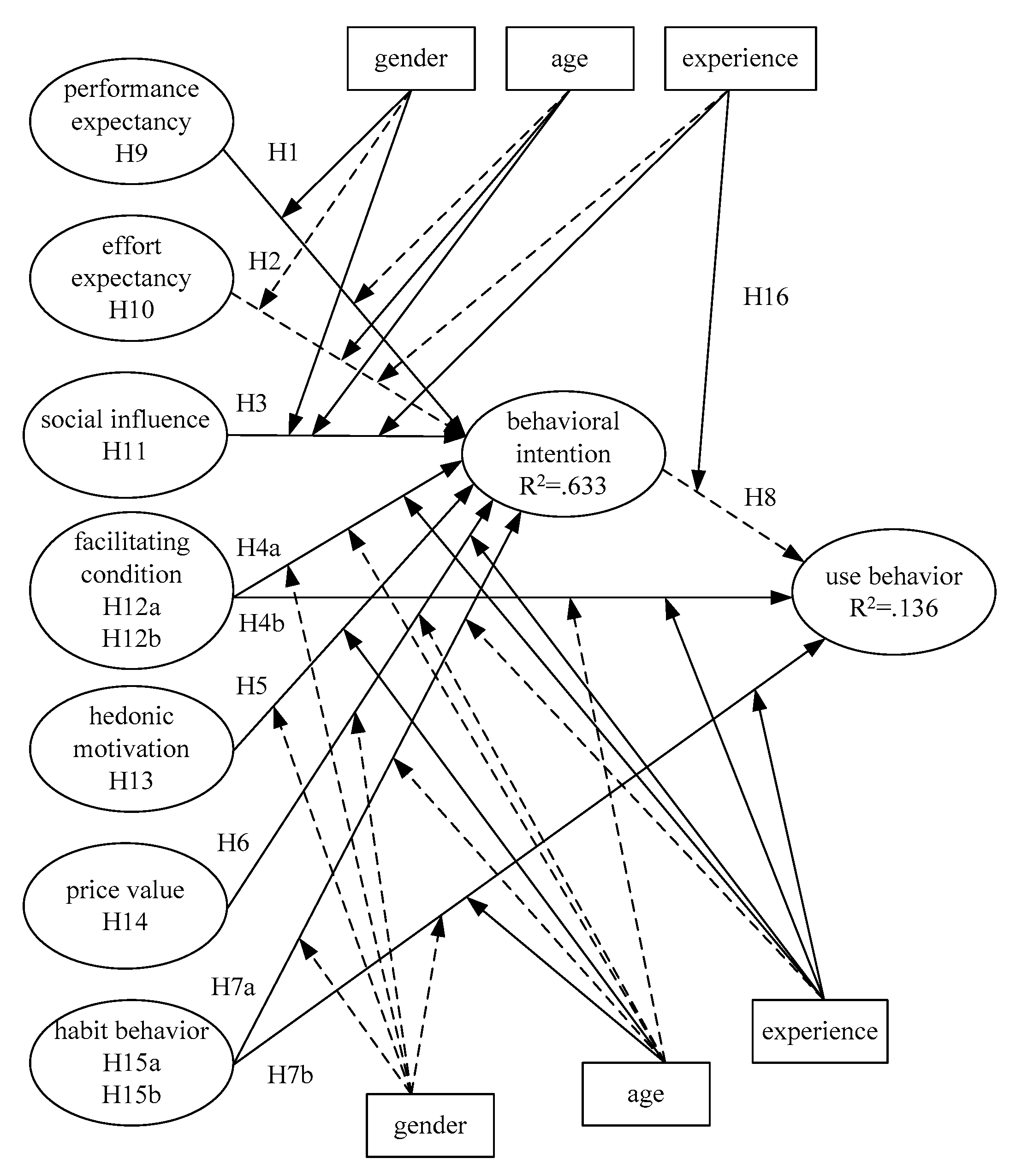

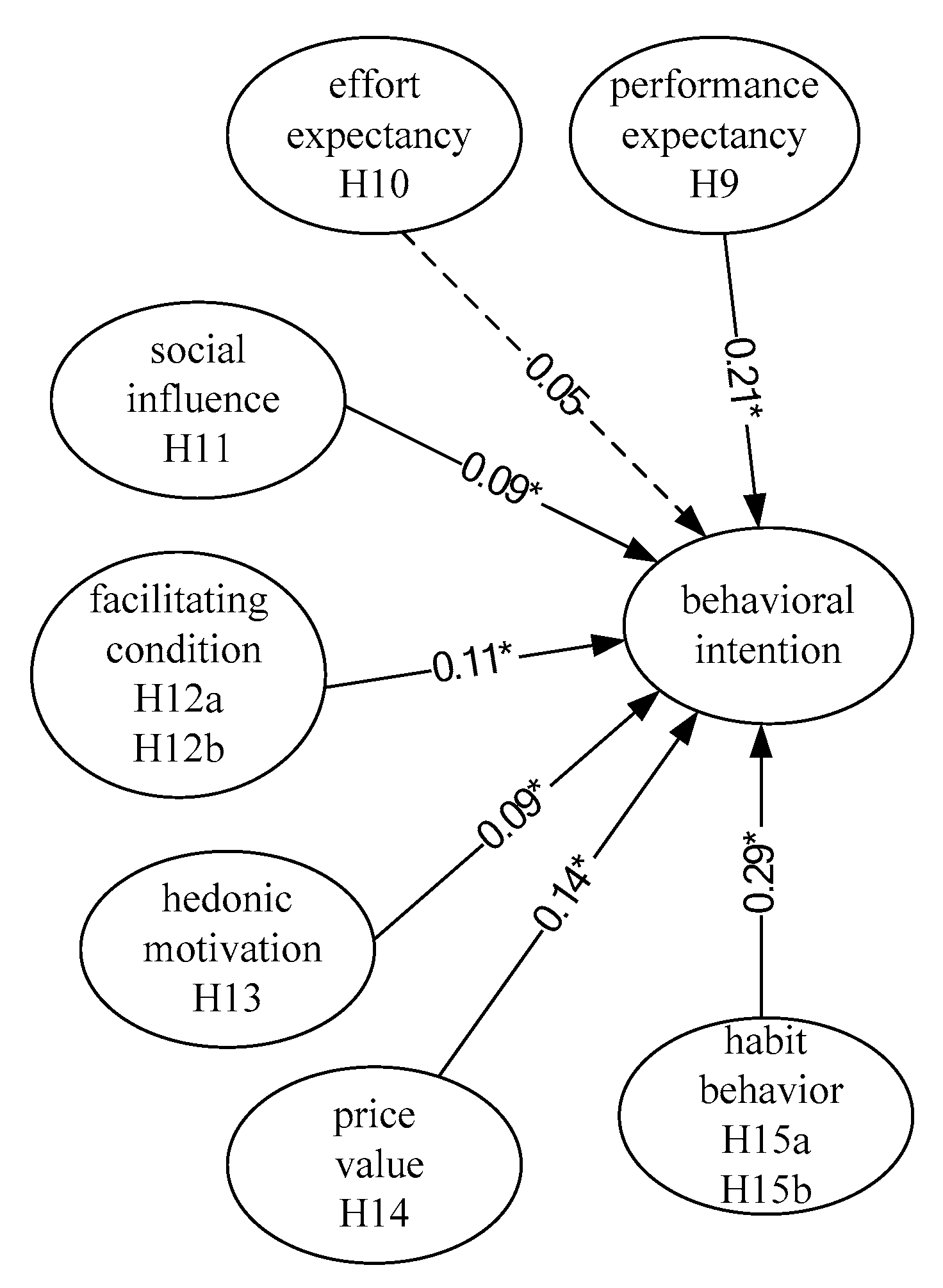

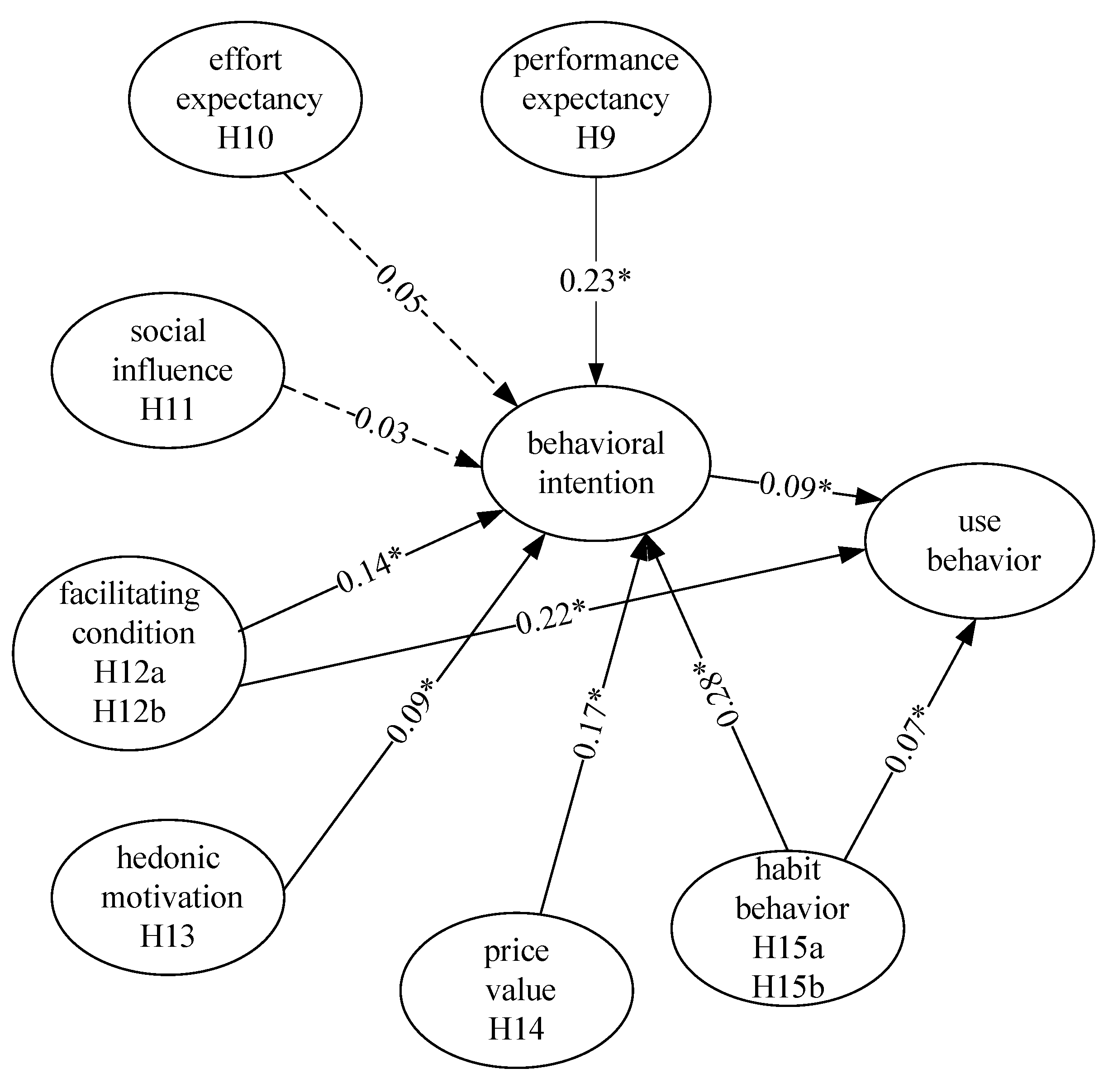
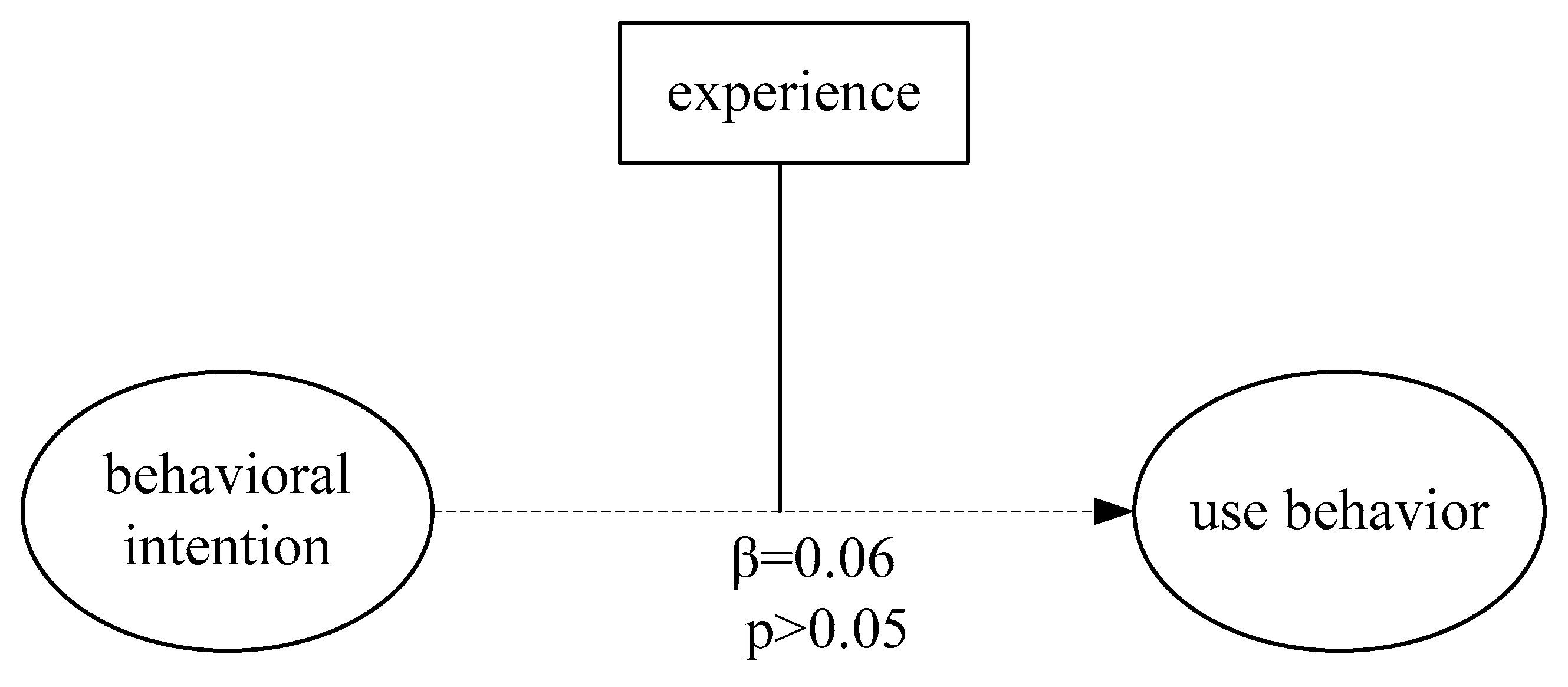
| Variable | Frequency | % |
|---|---|---|
| Gender | ||
| Males | 159 | 32.6 |
| Females | 329 | 67.4 |
| Age | ||
| 18–30 | 137 | 28.1 |
| 31–45 | 236 | 48.4 |
| 46+ | 115 | 23.6 |
| Taiwan citizen | ||
| Yes | 359 | 73.6 |
| No | 129 | 26.4 |
| Education | ||
| High School Graduate | 65 | 13.3 |
| Bachelor’s Degree | 270 | 55.3 |
| Graduate Degree | 153 | 31.4 |
| Married | ||
| Yes | 270 | 55.3 |
| No | 153 | 31.4 |
| Location of Residing Hotel | ||
| Taipei City | 173 | 35.4 |
| New Taipei city | 177 | 35.8 |
| Taichung City | 117 | 24 |
| Kaohsiung City | 121 | 24.8 |
| Online Purchases Previous Year (times) | ||
| 2–5 | 268 | 54.1 |
| 6–0 | 105 | 21.5 |
| 11–15 | 38 | 7.8 |
| 16+ | 81 | 16.6 |
| Hours Spent on Internet Surfing per week | ||
| <10 | 158 | 32.4 |
| 11–20 | 135 | 27.7 |
| 21–30 | 75 | 15.4 |
| 30+ | 120 | 26.4 |
| Construct | (1) | (2) | (3) | (4) | (5) | (6) | (7) | (8) | (9) | CR b | α c |
|---|---|---|---|---|---|---|---|---|---|---|---|
| (1) PE | 0.84 a | 0.91 | 0.86 | ||||||||
| (2) EE | 0.59 | 0.88 a | 0.93 | 0.90 | |||||||
| (3) SI | 0.43 | 0.33 | 0.80 a | 0.84 | 0.72 | ||||||
| (4) FC | 0.49 | 0.51 | 0.45 | 0.76 a | 0.85 | 0.76 | |||||
| (5) HM | 0.48 | 0.42 | 0.48 | 0.55 | 0.84a | 0.91 | 0.86 | ||||
| (6) PV | 0.57 | 0.49 | 0.52 | 0.58 | 0.63 | 0.82 a | 0.89 | 0.83 | |||
| (7) HB | 0.38 | 0.42 | 0.35 | 0.54 | 0.46 | 0.47 | 0.79 a | 0.87 | 0.80 | ||
| (8) BI | 0.58 | 0.52 | 0.43 | 0.58 | 0.55 | 0.61 | 0.60 | 0.85 a | 0.91 | 0.87 | |
| (9) UB | 0.13 | 0.19 | 0.24 | 0.24 | 0.22 | 0.32 | 0.23 | 0.22 | 1 | 1 | 1 |
| Hypotheses | Paths | Path Coefficient | p-Value |
|---|---|---|---|
| H1 | PE → BI | 0.211(β1) | p = 0.00*** |
| H2 | EE → BI | 0.025 (β2) | p = 0.27 |
| H3 | SI → BI | 0.075 (β3) | p = 0.03* |
| H4a | FC → BI | 0.194 (β4a) | p = 0.00*** |
| H4b | FC → US | 0.191 (β4b) | p = 0.00** |
| H5 | HM → BI | 0.100 (β5) | p = 0.01* |
| H6 | PV → BI | 0.225 (β6) | p = 0.00*** |
| H7 | HB → BI | 0.288 (β7a) | p = 0.00*** |
| H7 | HB →US | 0.075 (β7b) | p = 0.03* |
| H8 | BI → US | 0.051 (β8) | p = 0.13 |
| H9 | GDR × PE → BI | −0.080 (β9) | p = 0.02* |
| H9 | AGE × PE → BI | −0.006 (β10) | p = 0.44 |
| H10 | GDR × EE→BI | −0.055 (β11) | p = 0.09 |
| H10 | AGE × EE → BI | −0.077 (β12) | p = 0.03* |
| H10 | EXP × EE → BI | 0.038 (β13) | p = 0.17 |
| H11 | GDR × SI → BI | 0.111 (β14) | p = 0.00*** |
| H11 | AGE × SI → BI | 0.106 (β15) | p = 0.00*** |
| H11 | EXP × SI → BI | −0.091 (β16) | p = 0.01* |
| H12a | GDR × FC → BI | 0.046 (β12) | p = 0.13 |
| H12a | AGE × FC → BI | −0.026 (β13) | p = 0.26 |
| H12a | EXP × FC → BI | 0.067 (β14) | p = 0.05 |
| H12b | AGE × FC → UB | −0.046 (β15) | p = 0.13 |
| H12b | EXP × FC → UB | −0.066 (β16) | p = 0.05 |
| H13 | GDR × HM → BI | −0.023 (β12) | p = 0.29 |
| H13 | AGE × HM → BI | −0.099 (β13) | p = 0.01* |
| H14 | GDR × PV → BI | 0.047 (β14) | p = 0.12 |
| H14 | AGE × PV → BI | −0.051 (β15) | p = 0.10 |
| H14 | EXP × PV→BI | −0.196 (β16) | p = 0.00*** |
| H15a | GDR × HB → BI | −0.052 (β12) | p = 0.10 |
| H15a | AGE × HB → BI | −0.029 (β13) | p = 0.24 |
| H15a | EXP × HB→ BI | 0.016(β14) | p = 0.34 |
| H15b | GDR × HB→ UB | 0.004(β15) | p = 0.46 |
| H15b | AGE × HB→UB | 0.065 (β16) | p = 0.05 |
| H15b | EXP × HB→UB | 0.069(β15) | p = 0.04* |
| H16 | EXP × BI→UB | 0.072(β15) | p = 0.05 |
© 2019 by the authors. Licensee MDPI, Basel, Switzerland. This article is an open access article distributed under the terms and conditions of the Creative Commons Attribution (CC BY) license (http://creativecommons.org/licenses/by/4.0/).
Share and Cite
Chang, C.-M.; Liu, L.-W.; Huang, H.-C.; Hsieh, H.-H. Factors Influencing Online Hotel Booking: Extending UTAUT2 with Age, Gender, and Experience as Moderators. Information 2019, 10, 281. https://doi.org/10.3390/info10090281
Chang C-M, Liu L-W, Huang H-C, Hsieh H-H. Factors Influencing Online Hotel Booking: Extending UTAUT2 with Age, Gender, and Experience as Moderators. Information. 2019; 10(9):281. https://doi.org/10.3390/info10090281
Chicago/Turabian StyleChang, Chia-Ming, Li-Wei Liu, Hsiu-Chin Huang, and Huey-Hong Hsieh. 2019. "Factors Influencing Online Hotel Booking: Extending UTAUT2 with Age, Gender, and Experience as Moderators" Information 10, no. 9: 281. https://doi.org/10.3390/info10090281
APA StyleChang, C.-M., Liu, L.-W., Huang, H.-C., & Hsieh, H.-H. (2019). Factors Influencing Online Hotel Booking: Extending UTAUT2 with Age, Gender, and Experience as Moderators. Information, 10(9), 281. https://doi.org/10.3390/info10090281






